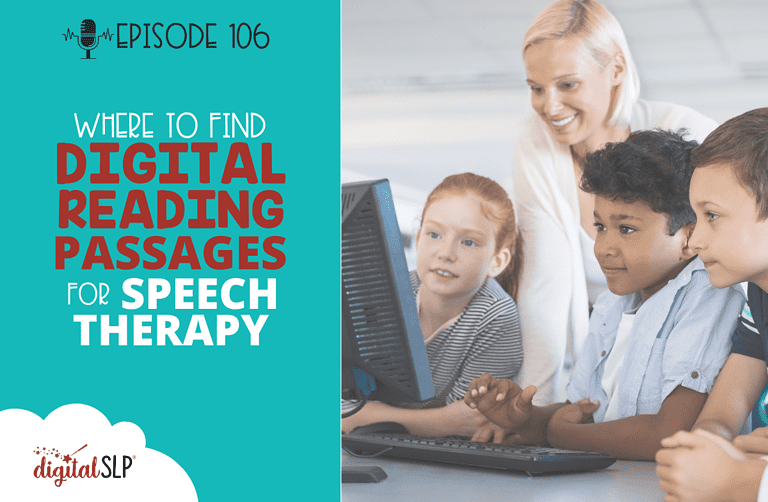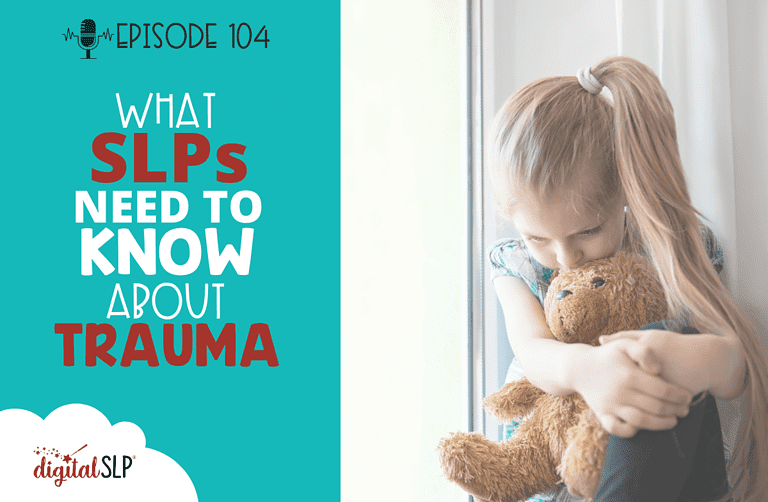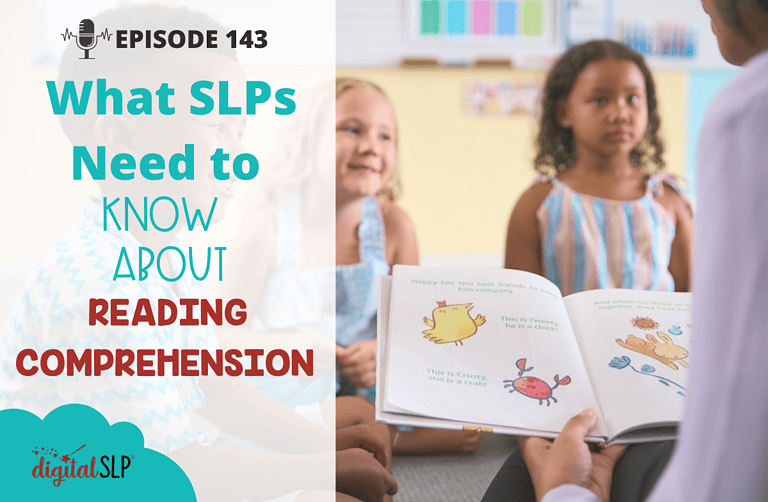In this episode, I discuss where to find digital reading passages for speech therapy, which can be a valuable addition to our speech therapy toolbox. If you’re in school, reading passages allow you to align your therapy materials with the classroom curriculum, and they can also be a great way to engage with students’ interests. You can also use digital reading passages to target almost any goal, especially with older students.
Just as an aside related to today’s podcast topic, The Digital SLP does have digital reading passages for speech therapy available as part of the subscription, so if you sign up for the free trial, be sure to check those out.
I also wanted to mention that I recently recorded a podcast episode about finding digital books for speech therapy and an episode about how to use digital books effectively in speech therapy. I think those might be good companions for today’s episode, so I’ll be sure to link them in the show notes.
References and Resources:
- ReadWorks
- Newsela
- The Learning Network – The New York Times
- Podcast Episode: Where to Find Digital Books for Speech Therapy
- Podcast Episode: How to Use Digital Books in Speech Therapy
- To sign up for a 7-day free trial, please check out: www.thedigitalslp.com/digitalslp
Full Transcript of Podcast: Where to Find Digital Reading Passages for Speech Therapy
Episode 106 - Where to Find Digital Reading Passages for Speech Therapy
Hi there and welcome back to another episode of the Speech Space Podcast, which is a podcast full of tips and resources for SLPs. I'm your host, Jessica Cassity, and this is Episode 106.
Today, we're going to be talking about where to find digital reading passages for speech therapy. Before we get started, I did want to take a moment to mention that this podcast is brought to you by The Digital SLP membership site, which is a site that features time-saving interactive digital resources that are all teletherapy platform-friendly. And you can learn more about that or sign up for a free trial by heading to thedigitalslp.com/digitalslp.
Just as a side note related to today's podcast topic, the Digital SLP membership does have reading passages available as part of the subscription, so if you sign up for the free trial, you'll want to be sure to check those out. I also wanted to mention that I recently recorded a podcast episode about finding digital books for speech therapy, and an episode about how to use digital books effectively in speech therapy, and I think those might be good companions for today's episode, so I'll be sure to leave the links for those in the show notes for you.
Before we jump into resources, let's talk a little bit about why digital reading passages can be such a useful part of our therapy toolbox. You know, what I love the most about digital reading passages is that they're different. It's not always easy to fit an entire book into one speech therapy session, and shorter passages allow us to target the same skills without spending quite as much time getting through the text itself. I also wanted to highlight the fact that digital passages are an especially good non-fiction resource. If you're in the schools, they allow you to align your therapy materials with classroom curriculum, and they can also be a great way to engage with students' individual interest. One final reason why I love working with digital passages is that they're so versatile. I talked about this a little bit in the episodes about digital books as well, and you can use digital reading passages to target almost any goal, especially with older students.
Now that you've hopefully gotten a little bit excited about using digital reading passages in speech therapy, let's talk about where we can find them.
The first resource I want to share about is ReadWorks. ReadWorks is an incredible tool that is completely free for educators. You can use it to find passages on almost any topic, and it also has excerpts from ebooks. The search tool is very robust, and it's easy to find passages that are geared towards a certain age or grade level. Most of the passages come with visual supports as well, and students are able to listen to passages as they read. The majority of the available passages are nonfiction, but there are also fiction and poetry options as well.
One of the best elements of ReadWorks is that it has an extensive library of supporting materials that go along with the passages. They range from simple wh-questions to inferential questions to materials that focus on vocabulary skills. There are also educator guides and webinars, and integration with Google Classroom and Clever, if your school or clinic uses those tools. If you work with school-age students, you really could plan an entire week of therapy just using ReadWorks. I'll make sure that I link that in the show notes and I encourage you to check it out.
The next resource I want to share with you is called Newsela. It's very similar to ReadWorks, although there isn't quite as much free content. Newsela has a wide variety of passages including non-fiction, fiction, and poetry. The passages can be sorted by topic or by grade level, and they have visuals and read-aloud options like ReadWorks. The major difference between ReadWorks and Newsela is that Newsela is more focused on news and current events, while ReadWorks has a more general library of content. This means that Newsela also includes editorial-type passages that are great for teaching persuasive writing or learning the difference between fact and opinion.
The main downside to Newsela is that it doesn't have as many options in terms of companion activities. Most of the articles and passages come with simple comprehension questions and quizzes, but that's pretty much it. I do still highly recommend this resource though, especially if you work with slightly older kids who are into current events. And before I forget, I wanted to point out that both ReadWorks and Newsela have some content that is especially designed for English language learners, so that's really helpful if you have students on your caseload who need that type of support.
The final digital passage resource that I want to talk about today is another great one! It is from The New York Times and it's called The Learning Network. The Learning Network is actually a huge collection of all kinds of education and literacy-related tools and activities, and it does include reading passages. I love it because it's free for educators and you don't have to be a New York Times subscriber to access it. Out of the three options we're talking about today, The New York Times Learning Network is probably the most comprehensive, and it's especially great for SLPs who work with middle school and high school age students. It has resources and passages divided by subject, including language arts, science, math, social studies, the arts, and current event, so it's excellent for aligning your therapy materials with the curriculum. It also has a great feature that's basically a curated collection of New York Times articles that have lesson plans to go along with them.
One of the things that I appreciate most about the Learning Network is that it has an entire section of accessible passages and activities that are especially designed for students with disabilities, so I definitely recommend checking that out. I know we're mostly focusing on passages today, but I did want to mention that The Learning Network has so many options for extending student learning. There are writing prompts, contests, videos, and more options as well. The Learning Network also has a lot of resources for SLPs and other educators, which are great for those days when you're not feeling very creative and you just need some support with thinking about how to use the tools as effectively as possible. I especially love their educator newsletter. It is free and it always has really inspiring ideas.
Now that you've gotten a quick introduction to ReadWorks, Newsela, and The Learning Network, I definitely encourage you to explore through them and see if they might be a good fit for you and your caseload. Like I mentioned before, The Digital SLP also has reading passages with associated activities and questions, so if you wanted to try those out as well, you can do that by going to thedigitalslp.com/digitalslp and sign up for the free trial. I hope that today's episode gave you some fresh ideas for where to find digital reading passages to use in your speech therapy sessions, and that you feel energized by all the possibilities that are out there.
If you enjoyed this episode, I would be so grateful if you would take a moment to leave a five-star review to make it easier for your fellow SLPs to find the show. We release new episodes twice a month on the first and the third Tuesdays. Also, if you would like to connect on Instagram, that's a great way to reach out if you need to. You can follow along @thedigitalslp. Thank you so much for tuning in, and I look forward to speaking with you again in a couple of weeks.













Recent Comments